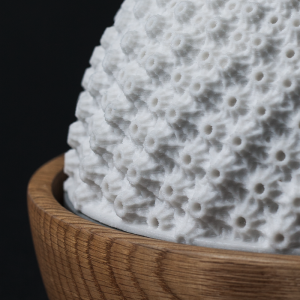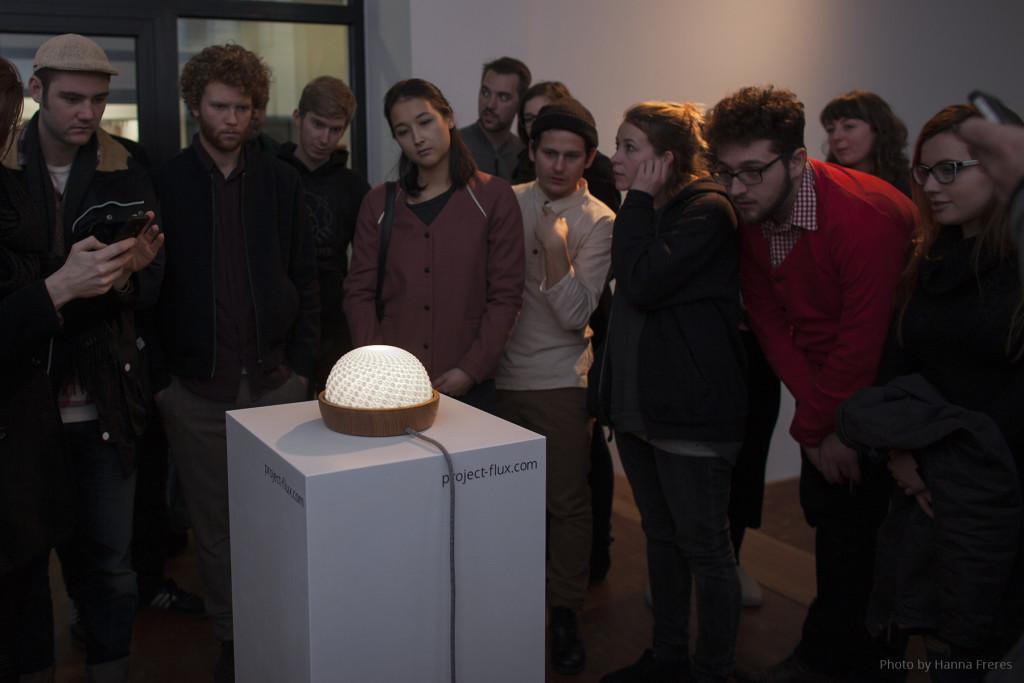 You may, at first glance, mistake it for some strange, exotic sea creature – a newly discovered species of jellyfish, perhaps, or sea urchin. Whatever it is, it’s beautiful. Luminous, undulating, it literally glows with life as it rotates in its bowl, beads of white sliding across its surface. It’s not a creature, though – in fact, incredibly, its surface is not even moving. This may seem impossible – I mean, look at it, it’s clearly moving, right? Nope. The only movement is a slow rotation, despite the fact that the surface seems to be crawling. That’s the power of optical illusion and mathematics.
You may, at first glance, mistake it for some strange, exotic sea creature – a newly discovered species of jellyfish, perhaps, or sea urchin. Whatever it is, it’s beautiful. Luminous, undulating, it literally glows with life as it rotates in its bowl, beads of white sliding across its surface. It’s not a creature, though – in fact, incredibly, its surface is not even moving. This may seem impossible – I mean, look at it, it’s clearly moving, right? Nope. The only movement is a slow rotation, despite the fact that the surface seems to be crawling. That’s the power of optical illusion and mathematics.
While Flux seems magical, its “movement” is thanks to the Fibonacci sequence, a relatively simple mathematical concept that lends itself to some amazingly complex theories and applications. The kinetic, 3D printed sculpture was created by Frederik Scheve, Janno Ströcker and Dieter Pilger, students at the Köln International School of Design, and 3D printed via Shapeways. They were inspired by Blooms, a series of 3D printed zoetropes created by artist John Edmark. Unlike Blooms, however, which utilizes a high speed camera to create the illusion of movement, Flux appears to move without any outside influence.
I’ll be completely honest – I don’t fully understand how it was done, but that’s the beauty of illusion. According to Flux’s creators:
“We envisioned a sculpture that displays an animation in the open physical space. The sphere is constructed according to the fibonacci sequence. It rotates in a certain speed and gets illuminated in a specific frequency. The animation can be seen just by looking at it with your eyes. No external devices like a strobe or a camera are required.”
 The illumination comes from a light installed inside the 3D printed sculpture. The beadlike protrusions on its surface were designed based on the Fibonacci principle, which is what makes them seem to slide along as the sculpture rotates. When I was a kid, I had several books of optical illusions that mesmerized me and also gave me wicked headaches if I stared at them for too long; it never occurred to me, at the time, to wonder about the many mathematical sequences that went into their design. Now, looking at Flux, I can see that it’s basically a 3D version of those optical illusion spirals I was so fascinated by.
The illumination comes from a light installed inside the 3D printed sculpture. The beadlike protrusions on its surface were designed based on the Fibonacci principle, which is what makes them seem to slide along as the sculpture rotates. When I was a kid, I had several books of optical illusions that mesmerized me and also gave me wicked headaches if I stared at them for too long; it never occurred to me, at the time, to wonder about the many mathematical sequences that went into their design. Now, looking at Flux, I can see that it’s basically a 3D version of those optical illusion spirals I was so fascinated by.
“Visual information is forwarded to the brain, where it is processed, interpreted and translated into sensory impressions,” the designers explain. “Generally speaking, visual perception is the product of filtering and reducing data, which enables us to depict our environment distinctly.”
Whoever said math and art have nothing to do with each other? Well – I did, as a sullen, math-hating art student in high school. I’ve since learned how very wrong I was. Mathematical concepts form the basis of so many great works of art, and Flux beautifully illustrates how magical those concepts can be. Discuss this incredible design in the 3D Printed Kinetic Sculpture forum thread on 3DPB.com.
Subscribe to Our Email Newsletter
Stay up-to-date on all the latest news from the 3D printing industry and receive information and offers from third party vendors.
You May Also Like
Profiling a Construction 3D Printing Pioneer: US Army Corps of Engineers’ Megan Kreiger
The world of construction 3D printing is still so new that the true experts can probably be counted on two hands. Among them is Megan Kreiger, Portfolio Manager of Additive...
US Army Corps of Engineers Taps Lincoln Electric & Eaton for Largest 3D Printed US Civil Works Part
The Soo Locks sit on the US-Canadian border, enabling maritime travel between Lake Superior and Lake Huron, from which ships can reach the rest of the Great Lakes. Crafts carrying...
Construction 3D Printing CEO Reflects on Being Female in Construction
Natalie Wadley, CEO of ChangeMaker3D, could hear the words of her daughter sitting next to her resounding in her head. “Mum, MUM, you’ve won!” Wadley had just won the prestigious...
1Print to Commercialize 3D Printed Coastal Resilience Solutions
1Print, a company that specializes in deploying additive construction (AC) for infrastructure projects, has entered an agreement with the University of Miami (UM) to accelerate commercialization of the SEAHIVE shoreline...






























